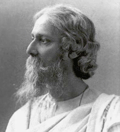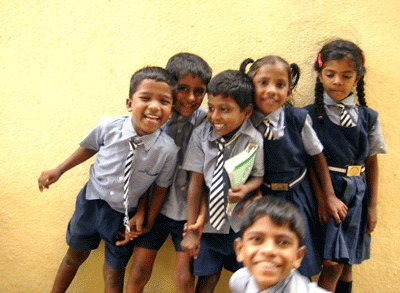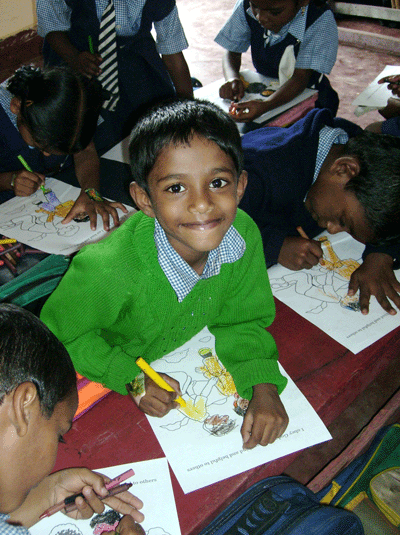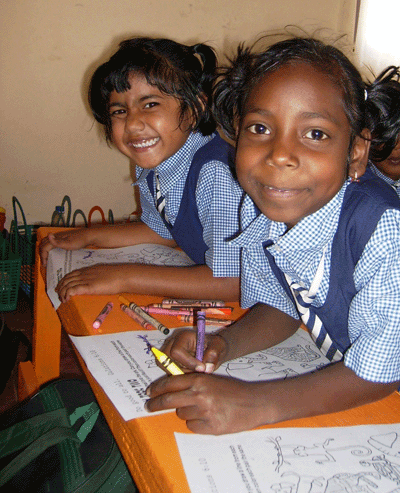
Rabindranath Tagore
Photo by Davita Maharaj, used with permission
“Where the mind is without fear, and the heart is held high,
Where the world is not broken up into fragments by narrow domestic walls,
Where the words came out from the depths of truth,
Where tireless striving stretches its arms towards perfection;
Where the clear stream of reason has not lost its way into the dreary desert sand of dead habits,
Where the mind is led forward by thee into everwidening thought and action -
Into that heaven of freedom,
My father, let my country awake.”
- Rabindranath Tagore, “Gitanjali”, 1912
Many Indians recognize Rabindranath Tagore as the winner of the 1913 Nobel Prize in Literature, and the philosopher who discoursed with Gandhi, Albert Einstein, W. B. Yeats, and other greats of his day. Many more Indians are admirers of his poetry and artwork. Throughout India, students recognize Tagore as the author of India’s national anthem, Jana Gana Mana.
Despite his fame in other arenas, Tagore’s progressive educational philosophy is largely forgotten today. The experimental models Tagore pioneered in his schools, Santiniketan and Sri Niketan, remain mere experiments. His ideals have not found their way into India’s schools; future generations have returned to rote-memorization as the predominant learning style. The above poem, which outlines Tagore’s vision for an innovative approach to education, is today mindlessly recited in thousands of schools across the country–in ironic contrast to the vision it advocates.
Yet Tagore’s vision for education is one that modern India cannot afford to forget.

Photo by Davita Maharaj, used with permission
1. “Where The Mind Is Without Fear”
In an environment devoid of fear, students have the confidence to express their thoughts freely and believe in their own learning ability. Fear of making mistakes prevents an individual from being free to venture a new thought, to experiment, to ask questions, to be creative, and to innovate. Because Tagore understood this, he was opposed to any form of corporal punishment as means of discipline. In his school, he cultivated internal discipline based on intrinsic motivations like joy and pursuit of creative tasks.
However, the majority of Indian teachers today believe that fear is a necessary condition for learning. Students’ mistakes are mercilessly and sometimes violently punished, rather then being seen as a necessary part of the learning process. Accroding to one Bangalorean teacher, “To keep an Indian teacher from hitting her students would be similar to taking an Indian's rice away, and expecting her to simply be content with sliced white bread and butter.” Even parents come to school with candles and matches, instructing the teacher to “light the candles and pour hot wax” on the child’s arm if she disobeyed. Others bring chili powder to school, requesting the teacher sprinkle it into the child’s eyes, or sticks with which to flog their child.
Our nation’s creative growth is stunted by an educational environment where children cannot learn without fear of a beating, or worse. In April 2009, eleven-year-old Shanno Khan died as a result of being beaten by her teacher and made to stand in the scorching Delhi sun for hours. Her crime? Being unable to recite the English alphabet. Such headlines are frequent and widespread, as children are “subdued at last into silence by punishment”, as Tagore put it. Adults continue to view children as their property, to be beaten at will – not as individuals with personal rights and dignity.
2. “And The Heart Is Held High”
Central to Tagore’s education vision was the nurturing of students’ souls. For Tagore, the purpose of education was not just employment – but more importantly, personal fulfilment and self-improvement. As Narmadeshwar Jha explains in his UNESCO article on Tagore, “science without the constraint of self-knowledge…leads to an endless desire for material goods and well-being, and the meaningless pursuit of the instruments of war and power…That is why both spiritual and scientific knowledge are considered by Tagore as equally important”.
In The Clash Within, Martha Nussbaum explains that at Tagore’s school, Santiniketan, the education was “infused with passion and delight because of the way in which education was combined with dance and song.” This joy and passion carried over to the rest of children’s studies, enabling them to perform well in standard examinations. Tagore believed in starting the learning process with those things close to a child’s heart, rather than beginning with a textbook. Through frequent excursions in nature, games, songs, drama, readings, celebrations, and spiritual teachings, he sought to develop the souls of his children.
Amartya, a former student, writes that at Santiniketan, the emphasis was on “self-motivation rather than on discipline, and on fostering intellectual curiosity rather than competitive excellence.” Lest one assume that Tagore’s focus on the arts disabled intellectual growth, this student grew up to become Harvard Economist and Nobel Memorial Prize winner Amartya Sen. Reflecting on his education, Sen marvels, “Tagore was concerned not only that there be wider opportunities for education across the country…but also that the schools themselves be more lively and enjoyable…”
In India’s current education system, focus on education as a means to future employment creates an obsession with passing examinations, which in turn forces textbook-centred teaching. Learning has little relevance to students’ lives and interests, and thus is not enjoyed and valued as an end-in-itself. With success attributed soley to science and technology skills, teachers and parents disregard the development of creativity and artistic skills. India’s schools have yet to catch up with Tagore’s vision.
3. “Where The World Is Not Broken Up Into Fragments By Narrow Domestic Walls”
A key concept in Tagore’s model is that of promoting a ‘narrative imagination’ – the nurturing of creativity, empathy, and diversity. For Tagore, one of the central skills needed for a democratic society is the ability to imagine what it might be like to be in the shoes of a person different from oneself, to see things from multiple perspectives.
The inability to empathize with others’ viewpoints is a key cause of apathy, oppression, racism, violence, and war in today’s world. In his 1917 book, Personality, Tagore writes that “we may become powerful by knowledge, but we attain fullness by sympathy…But we find that this education of sympathy is not only systematically ignored in schools, but it is severely repressed.”
The narrative imagination is cultivated, above all, through literature and the arts – a central and revolutionary feature of Tagore’s curriculum. Literature and the arts play a crucial role in bridging the divide between people. When we listen to another person’s story it touches our emotional and imaginative core, leading us to inhabit their perspective and experience their common humanity. A new conviction of the essential humanity of the “Other” changes “us” and “them” into “we”, and motivates us to act for the common good.

Photo by Davita Maharaj, used with permission
4. “Where Tireless Striving Stretches Its Arms Towards Perfection”
Tagore considered lack of education to be the main obstacle to India’s progress. He saw education as a key tool for promoting a more just and equitable society. Instead of targeting elite Brahmin boys (as did gurus in the brahmacharya tradition), Tagore stressed educating the ‘dregs’ of society: the poor, women, girls, socio-cultural minorities, and rural children. This, of course, stood in sharp contrast to the hierarchy of the caste system, which stunts India’s growth even today.
Tagore’s model prioritised education of the rural majority. He believed that a country’s education system must be intimately connected with the life of its people. Thus any education offered in India, whether at school or university level, must be connected with patterns of rural living and aimed at rejuvenating rural life. The major thrust of his program at Sri Niketan was to apply knowledge for the betterment of all aspects of rural life – including agriculture, education, health, and social issues. Moreover, consonant with the latest educational research, Tagore placed strong emphasis on conducting early education in the child’s mothertongue, to give an equal opportunity to children from diverse backgrounds to learn well.
Yet a hundred years later, the deep fragments in our minds and society remain. According to Salil Mekaad in Hindustan Times, UNICEF’s most recent survey found that 63% of Dalit children are subjected to caste discrimination at lunchtime in government schools. Their utensils and plates must be marked and kept separate, so as not to taint other students with their “untouchability.” 78% of Dalit students are forced to sit in the backbenches or kept from sitting in the front rows, while 79% of Dalit students are forced to clean the schools.
5. “Where The Clear Stream Of Reason Has Not Lost Its Way Into The Dreary Desert Sand Of Dead Habits”
Tagore understood that one of the greatest ills plaguing our education and society is lack of critical thinking. In his efforts to improve living conditions in India’s villages, he realised that the population first needed to reject blind belief in fate and realize the importance of their own efforts. Our mental passivity is a direct result of classrooms that condition students to passively accept what is dictated by textbooks or teachers, without raising questions or disagreements. Students are still viewed as mere ‘containers’ to be passively ‘filled’ by the teacher.
A system that fails to teach students to understand, question, critically reflect and act upon what they learn, produces adults who fail to understand, question, critically reflect and act upon their society. It creates a nation whose citizens are taught to submit rather than to question; to adapt to the world as it is, rather than actively trying to change it; to accept rather than to critique the false superstitions, blind traditions, media slogans, or unjust social systems that are oppressing them.
In contrast, Tagore taught students to critically examine all beliefs, traditions, and statements, and to accept only those that stood the test of reason, rather than blindly accepting them on the basis of authority. He used education as a tool for social change by making young people rational independent thinkers, rather than blind followers of rituals and traditions. Modern India is desperately in need of such teaching. Only when our education system begins to encourage students to think for themselves, question, debate, and form their own opinions, will education become truly liberating, empowering and socially reforming.
6. “Into That Heaven Of Freedom”
Promoting the freedom of the child is at the heart of Tagore’s philosophy. Believing that the limitless development of human potential is possible only in an environment free from any kind of bondage, Tagore writes in his book, Personality, “I established my institution in a beautiful spot away from the town where the children had the greatest freedom possible under the shade of ancient trees.”
Tagore placed the child at the centre of the learning process. Likewise, many progressive learning theories today seek to draw from the child’s existing knowledge to create an engaging, relevant, and joyous learning process. Students should be given the freedom to explore, inquire, experiment, and discover things for themselves. Tagore wrote, "Not hammer strokes, but dance of the water, sings the pebbles into perfection." Tagore did not believe in “hammering” information into children’s minds, imposing a single belief system or ideology on them, and forcing them into pre-determined moulds. Respecting the dignity of the child implies respecting the child’s curiosity, their freedom to question, to explore, to imagine, to criticise, even to disagree, and to make choices for themselves.
7. “Where The Mind Is Led Forward By Thee Into Ever Widening Thought And Action . . . My Father, Let My Country Awake”
Why has Indian education still not caught up with Tagore’s vision, over a century later? Some attempts have been made to bring the changes Tagore advocated: wide-scale government programs have been implemented (such as DPEP and the present Sarva Shiksha Abhiyan), large funds have been spent, new textbooks have been written, teachers have been retrained in progressive pedagogies. Yet millions of children remain out of school, and the quality and nature of Indian schools remain essentially unchanged, especially for the underprivileged majority. India continues to flounder with problems like children out of school, teacher absenteeism, low teacher salaries, low educational investment, and rote-learning dominated classrooms.
But these are mere symptoms of the crisis plaguing Indian education. The roots lie woven deeper, in the cultural ethos of our society – our values, mindsets, worldviews. According to NCERT Director Krishna Kumar, the problem is political and public apathy: “India’s present-day society lacks the desire to see every child at school…A lot of people…worry about their own children but don’t feel hurt or pained when they see others’ children exploited or treated badly. In such a social ethos, any government will have difficulty in pushing radical educational reforms.” Universal quality education will simply not take root in a society that does not necessarily believe in the equality of every child, that sees poverty as ordained by karma and therefore asserts no personal responsibility for ending it, that places low status on women and consequently teachers who are predominantly female..
Regardless of the external models imposed on a school, the values that will be taught are those embedded in the larger cultural ethos of the society. In a social context that is hierarchical, where authority figures are to be feared and their words dutifully obeyed, how can teachers readily promote democratic learning styles and encourage students to question what they say? In an ethos which believes that only a minority of children are talented and capable of succeeding, isn't it natural that the least attention and resources are given to lower social groups or children with special needs?
As Tagore said, an awakening is needed in our country – renewal in our beliefs and values. Unless education reform efforts begin to address the deeper elements in our collective mindset that may be restricting change, reforms will remain piecemeal and Tagore’s vision for an educated India will remain a distant dream.
In his poem, Tagore not only lays out the ideal, but also proposes the way forward: “everwidening thought and action”. To bring about change, we must shift the way our society thinks about education: to a culture that prioritizes education; that ensures that learning is personally meaningful and socially relevant; that sees every subject of study as valuable; that redefines educational success beyond a narrow preoccupation with marks; that encourages students not to passively memorize and accept but to think for themselves, form their own opinions, and act for the collective good.

Photo by Davita Maharaj, used with permission
Then we must tangibly embody this shift, through visible action: building public opinion to make education a national priority, recruiting businesses to invest in education; helping improve government schools; urging private schools to open their doors to the poor; advocating special priority for those typically overlooked by our system; raising the status of the teaching profession; encouraging education and careers in humanities and arts; and devoting our own time, efforts, and resources to promoting quality education for the underprivileged majority.
India’s democracy is in great danger if it fails to take Tagore’s legacy to heart. For India to progress, we need citizens who can think and speak boldly, whose souls are nurtured toward creativity and innovation, who embrace diversity through empathizing with others; who are committed to promoting a more just and inclusive society, who are able to think independently and freely. Only the kind of education that Tagore envisioned can equip our citizens to meet the challenges of our modern, globalized world.
*This article is first published in The International Indian, Vol. 16.3, July/August 2009.
Leave a Comment: